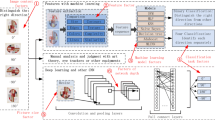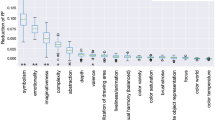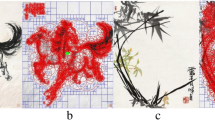Abstract
Artists decide the orientation at which an abstract painting should be hung based on their ideas, but the correct orientation is not obvious to other viewers. Some studies have found that abstract paintings at the correct orientations generally get higher aesthetic ratings from viewers. This encourages us to deal with the problem of orientation judgment for abstract paintings through machine learning. First, we design a group of methods to extract features from paintings based on the theories in abstract art. Then a machine leaning framework is proposed using Naive Bayes classifier and BP neural network classifier for training and orientation testing. Experiments show that it can classify abstract paintings into up and non-up ones with performance comparable to human. This is the first work of orientation judgment for abstract paintings through computer simulation, and the results demonstrate the validity of abstract art theories used for feature definition. This work provides a new scheme for exploring the relationship between aesthetic quality of abstract paintings and their computational visual features.









Similar content being viewed by others
References
Amirshahi S, Koch M, Denzler J, Redies C (2012) Phog analysis of self-similarity in esthetic images. In: Proceedings of SPIE (HVEI XVII), vol 8291, p 82911J
Arnheim R (2004) Visual Thinking, 1st Edn. University of California Press. 30-5th Anniversary Printing edition
Barla A, Franceschi E, Odone F, Verri A (2002) Image kernels. In: Lee SW, Verri A (eds) Pattern Recognition with Support Vector Machines, Lecture Notes in Computer Science, vol 2388, pp 83–96. Springer, Berlin
Bosch A, Tisserman A, Munoz X (2007) Representing shape with a spatial pyramid kernel. In: Proceedings of CIVR 2007
Dalal N, Triggs B (2005) Histograms of oriented gradients for human detection. In: Schmid C, Soatto S, Tomasi C (eds) International Conference on Computer Vision & Pattern Recognition, vol. 2, pp. 886–893. INRIA Rhône-Alpes, ZIRST-655, av. de l’Europe, Montbonnot-38334. http://lear.inrialpes.fr/pubs/2005/DT05
Datta R, Joshi D, Li J, Wang JZ (2006) Studying aesthetics in photographic images using a computational approach. In: Proceedings of the European Conference on Computer Vision (ECCV), vol 3, pp 288–301
Gossweiler R, Kamvar M, Baluja S (2009) What’s up captcha? a captcha based on image orientation. In: In Proceedings of the International World Wide Web Conference Committee (IW3C2), pp 841–850. ACM
Hedges S (2008) Image analysis of renaissance copperplate prints. Computer image analysis in the study of art 6810
Hollitt C, Deeb AS (2012) Determining image orientation using the hough and fourier transforms. In: Image and Vision Computing New Zealand, IVCNZ’12, Dunedin, New Zealand - November 26 – 28, 2012, pp 346–351. doi:10.1145/2425836.2425904
Irfan M, Stork D (2009) Multiple visual features for the computer authentication of jackson pollock’s drip paintings: Beyond box-counting and fractals. SPIE Electronic Imaging: Machine vision applications II 7251
Isola P, Xiao J, Torralba A, Oliva A (2011) What makes an image memorable?. In: IEEE Conference on Computer Vision and Pattern Recognition (CVPR), pp 145–152
Jiang S, Huang Q, Ye Q, Gao W (2006) An effective method to detect and categorize digitized traditional chinese paintings. Pattern Recogn Lett 27:734–746
Johnson MG, Muday JA, S JA (2010) When viewing variations in paintings by mondrian aesthetic preferences correlate with pupil size. Psychology of Aesthetics, Creativity, and the Arts 4(3):161–167
Jones-Smith K, Mathur H (2006) Revisiting pollock’s drip paintings. Nature 444:E9—E10
Kandinsky W (2012) Point and line to plane. Dover Publications
Ke Y, Tang X, Jing F (2006) The design of high-level features for photo quality assessment. In: Proceedings of the IEEE Comput. Soc. Conf. Comput. Vision Pattern Recogn., vol 1, pp 419–426
Latto R, Brain D, Kelly B (2000) An oblique effect in aesthetics: Homage to mondrian. Perception 29(8):981–987
Li C, Chen T (2009) Aesthetic visual quality assessment of paintings. IEEE Journal Of Selected Topics In Signal Processing 3(2):236–252
Lindauer MS (1969) The orientation of form in abstract art. Proceedings of the Annual Convention of the American Psychological Association 4(1):475–476
Lyu S (2005) Automatic image orientation determination with natural image statistics. In: Proceedings of the 13th annual ACM international conference on Multimedia, pp 491–494. ACM
Machajdik J, Hanbury A (2010) Affective image classification using features inspired by psychology and art theory. In: Proceedings of the International Conference on Multimedia, MM ’10, pp 83–92. doi:10.1145/1873951.1873965. ACM, New York
Mallon B, Redies C, Hayn-Leichsenring GU (2014) Beauty in abstract paintings: perceptual contrast and statistical properties. Front Hum Neurosci 8
Marchesotti L, Perronnin F, Larlus D, Csurka G (2011) Assessing the aesthetic quality of photographs using generic image descriptors. In: IEEE Conference on Computer Vision and Pattern Recognition (CVPR)
Mather G (2012) Aesthetic judgement of orientation in modern art. Perception 3:18–24
Plumhoff JE, Schirillo JA (2009) Mondrian, eye movements, and the oblique effect. Perception 38(5):719–731
Redies C, Amirshahi SA, Koch M, Denzler J (2012) Phog-derived aesthetic measures applied to color photographs of artworks, natural scenes and objects. In: ECCV 2012, vol. Part I, LNCS 7583, pp 522–531
Sartori A, Yanulevskaya V, Salah AA, Uijlings J, Bruni E, Sebe N (2015) Affective analysis of professional and amateur abstract paintings using statistical analysis and art theory. ACM Trans Interact Intell Syst 5(2):8:1–8:27. doi:10.1145/2768209
Shahram M, Stork D, Donoho D (2008) Recovering layers of brush strokes through statistical analysis of color and shape: An application to van gogh’s self portrait with grey felt hat. Computer image analysis in the study of art 6810:68,100D–1–8
Stork DG (2009) Computer vision and computer graphics analysis of paintings and drawings: An introduction to the literature. In: CAIP 2009, vol LNCS 5702, pp 9–24
Taylor RP, Micolich AP, Jonas D (1999) Fractal analysis of Pollock’s drip paintings. Nature 399:422
Yanulevskaya V, Uijlings J, Bruni E, Sartori A, Zamboni E, Bacci F, Melcher D, Sebe N (2012) In the eye of the beholder: Employing statistical analysis and eye tracking for analyzing abstract paintings. In: MM’12
Zhao S, Gao Y, Jiang X, Yao H, Chua TS, Sun X (2014) Exploring principles-of-art features for image emotion recognition. In: Proceedings of the ACM International Conference on Multimedia, MM’14, pp 47–56. doi:10.1145/2647868.2654930. ACM, New York
Acknowledgments
This work is supported by the National Natural Science Foundation of China with project No. 61172104.
Author information
Authors and Affiliations
Corresponding author
Rights and permissions
About this article
Cite this article
Liu, J., Dong, W., Zhang, X. et al. Orientation judgment for abstract paintings. Multimed Tools Appl 76, 1017–1036 (2017). https://doi.org/10.1007/s11042-015-3104-5
Received:
Revised:
Accepted:
Published:
Issue Date:
DOI: https://doi.org/10.1007/s11042-015-3104-5




